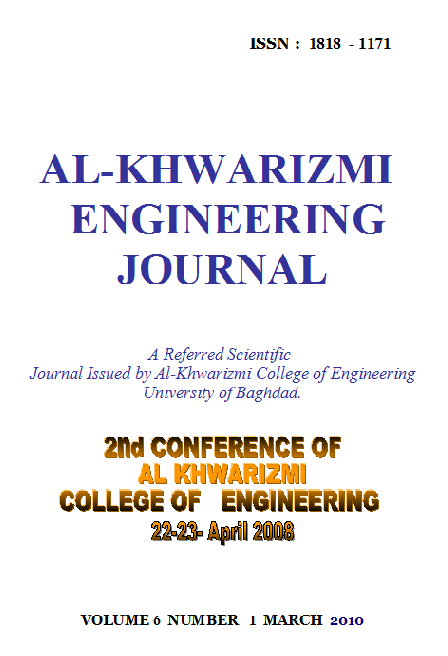Estimation of Extract Yield and Mass Transfer Coefficient in Solvent Extraction of Lubricating Oil
Abstract
An investigation was conducted to suggest relations for estimating yield and properties of the improved light lubricating oil fraction produced from furfural extraction process by using specified regression.
Mass transfer in mixer-settler has been studied. Mass transfer coefficient of continuous phase, mass transfer coefficient of dispersed phase and the overall mass transfer coefficient extraction of light lubes oil distillate fraction by furfural are calculated in addition to all physical properties of individual components and the extraction mixtures.
The effect of extraction variables were studied such as extraction temperature which ranges from 70 to 110°C and solvent to oil ratio which ranges from 1:1 to 4:1 (wt/wt) were studied.
The results of this investigation show that the extract yield E decreased with decreasing solvent to oil ratio in extract layer and increased with increasing temperature. The fraction of total solvent in the raffinate phase decreased with increasing oil to solvent ratio in raffinate layer and increased with increasing temperature. Solvent to oil ratio in extract layer decreased with increasing temperature and increased with increasing solvent to charge oil ratio at constant temperature. Oil to solvent ratio in raffinate decreased with increasing temperature and increased with increasing solvent to charge oil ratio at constant temperature.
Estimated functions are the best modeling function for prediction extraction data at various operating conditions.
Mass transfer coefficient of continuous phase kc and mass transfer coefficient of dispersed phase kd are increased with increasing temperature and solvent charge to oil ratio at constant temperature. The over all mass transfer coefficient Kod is increased with increasing temperature and solvent to charge oil ratio; while Kod a is increased with temperature and decreased with solvent to charge oil ratio.
Downloads
References
[2] Kalichevsky,V.A.,Ind.Eng.Chem.,38,1009(1946)
[3] Kalichevsky,V.A.,Natl.Petroleum News,38,R-613(1946)
[4] Takahashi, K., Nii, S., Merrories of the School of Engineering, Nagoya University, Science Research, 51(1), 1999.
[5] Wichterlova, J., Rod, V., Chemical Engineering Science, 54, 4041(1999).
[6] Mostaedi,M.,Safdari,S. and Moosavian,M.,Braz.J.Chem.Eng.,25(3),2008
[7] Treybal,R.E.,Chem.Eng.Prog.,60(5),77(1964);62(9),67(1966)
[8] Hossein,A.,Mohammad,A. and Reza,S.R,Iran.J.Chem.Eng.,25(4)2006.
[9] Calderbank,P.H. and M.B.Moo-Young,Chem.Eng.,16,39(1961)
[10] Jordan,D.G.,Chem.Process Development, Part 2,New York(1968)
[11] Rushton,J.H.s.Nagata and T.B.Rooney,A.I.Cb.E.Jl,10,298(1964)
[12] Rushton,J.H.,E.W.Costich and H.J.Everett,Chem.Eng,Prog.,52,515(1956)
[13] Treybal,R.E.,Ind.Eng.Chem.,53,597(1961)
[14] Stanley,M.W.,"Chemical Process Equipment Selection and Design",1990
[15] Treybal,R.E.,"Mass Transfer operations",Mc Graw-Hill,New York,1980
[16] Sadiq, R. J,M.Sc.Thesis, Baghdad University (2006).
[17] Stanley,C.L. and Mary,C.,"Mathematics for Engineers and Applied Scientists",1985
[18] Warren,L.M.,Julian,C.S,Peter,H.,"Unit Operations of Chemical Engineering", Mc Graw-Hill,2001
[19] Christie,J.G,"Transport Processes and Unit Operation",1983
[20] Treybal, R. E., Chem.Eng. Proog., 62(9), 67(1966).
[21] Kafarov, V. V. and M. Babanov, Zb. Prikl. Kbim., 32, 789(1959).
Downloads
Published
Issue
Section
License
Copyright: Open Access authors retain the copyrights of their papers, and all open access articles are distributed under the terms of the Creative Commons Attribution License, which permits unrestricted use, distribution, and reproduction in any medium, provided that the original work is properly cited. The use of general descriptive names, trade names, trademarks, and so forth in this publication, even if not specifically identified, does not imply that these names are not protected by the relevant laws and regulations. While the advice and information in this journal are believed to be true and accurate on the date of its going to press, neither the authors, the editors, nor the publisher can accept any legal responsibility for any errors or omissions that may be made. The publisher makes no warranty, express or implied, with respect to the material contained herein.












